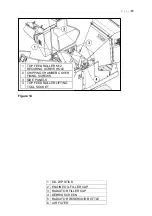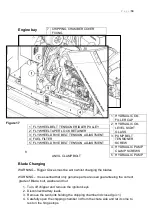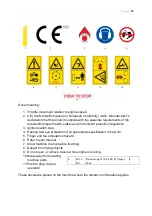
P a g e
|
23
•
Do not steer the machine while on ramps, this is extremely dangerous. If
adjustment has to be made, drive back onto ground or vehicle bed, steer, then
negotiate the ramps.
•
Drive slowly while loading/unloading and take care when the machine passes
over hump at the ramp to bed join.
•
Position the machine at the trailer/vehicle bed centre.
•
Fasten machine securely to transport vehicle via both lashing eyes on track
base front and rear. Use appropriately rated cables, chains or ratchet straps.
Make sure that no securing passes over or traps any hydraulic hoses.
•
Clear machine of loose woodchip material before departing.
•
Ensure the chute is securely fixed at the inboard position before departing.
•
Ensure that the hopper tray is closed in the up position and the locking latch is
fully engaged before departing.
Care of rubber tracks
•
Do not manoeuvre on hard, stony and highly abrasive surfaces.
•
Do not leave tracks exposed to direct sunlight for more than 3 months.
•
Avoid aggressive steering on asphalt and concrete as this will cause
excessive track wear. Also avoid driving on asphalt that is hot and above
60°C, it will damage the tracks and asphalt.
•
Loose tracks can be detached and damaged when manoeuvring on very
uneven ground.
•
Tracks are for use on soft ground. They will rapidly deteriorate if used on hard
or abrasive surfaces such as sand, stone or minerals.
•
Do not let synthetic oils or fuel get onto the track. Clean immediately if this
occurs.
•
Do not use tracks in a marine or coastal environment as salt and salt air will
corrode the steel inner core and track components.
Routine maintenance
The following must be checked at least on a daily basis during use (also see Service
schedule):
• Check engine oil. See Figure 15.
• Check water level in radiator reservoir bottle. See Figure 15.
• Check debris screen on front of radiator and remove any debris. See Figure
11.
• Check hydraulic oil level. When the machine is new, the oil level may drop
during initial use. Regularly check and top-up until level settles. If a top up is
required, thoroughly clean around filler cap before removing to help prevent
debris falling into the oil tank, top up as required and replace filler cap. See
Figure 16.
Содержание TR6
Страница 5: ...P a g e 4 ...













































